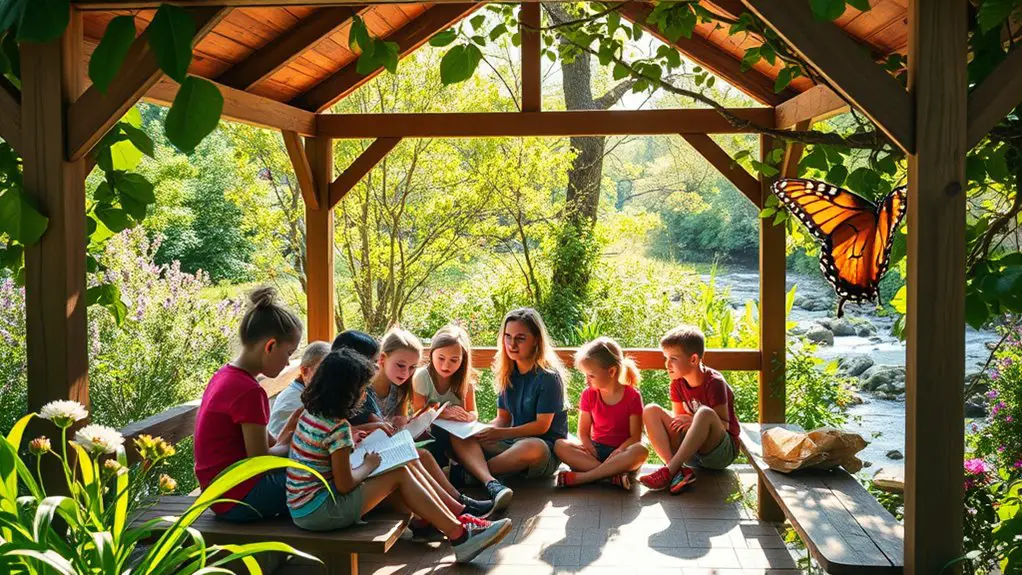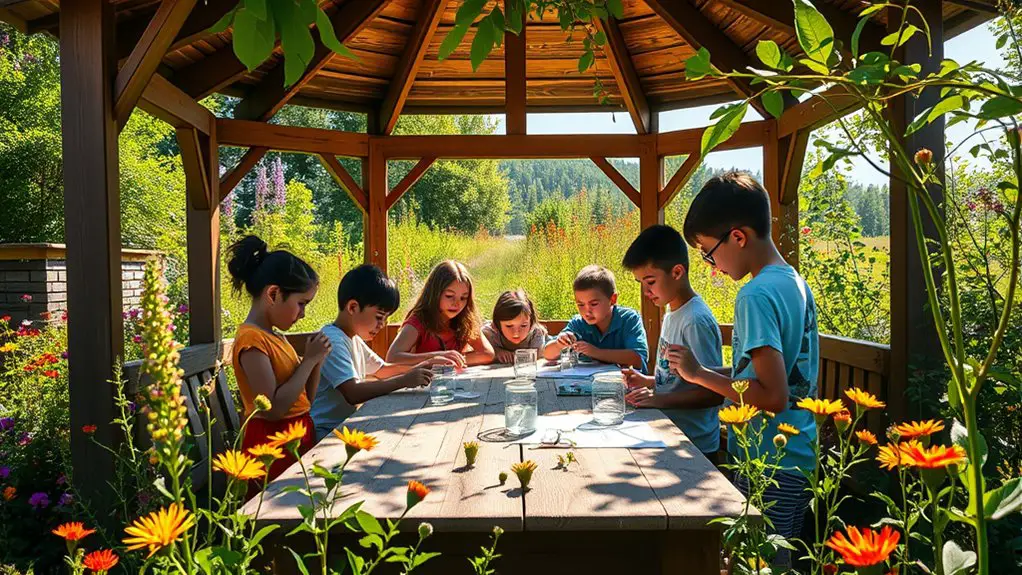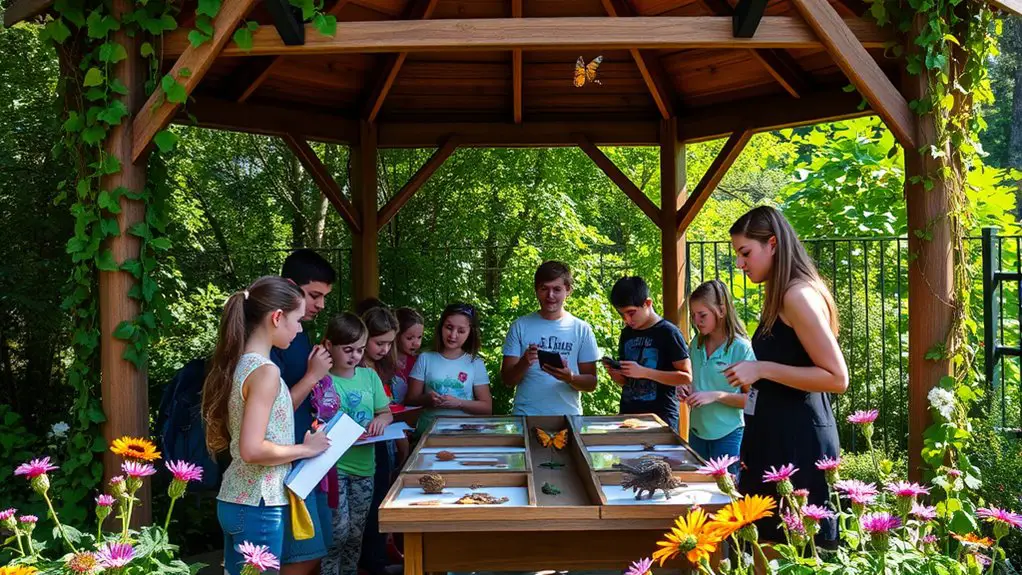Teaching science outside in a gazebo can transform learning into an engaging adventure. You’ll enhance students’ creativity and focus while they observe nature, conduct hands-on experiments, and collaborate with peers. Setting up your gazebo with designated activity areas and weatherproof materials guarantees a comfortable learning environment. Encourage nature journaling and interactive experiments to spark curiosity. By embracing the outdoor space, you’ll create memorable experiences for your students—and discover even more strategies to maximize your time outdoors.
The Benefits of Outdoor Learning in a Gazebo

When you step into a gazebo for outdoor learning, you’ll discover an environment that sparks creativity and engagement. Surrounded by nature, you can tap into the numerous nature benefits that enhance the learning experience. Research shows that outdoor settings greatly improve focus and retention, making lessons more impactful. The fresh air and natural light invigorate both you and your students, fostering a sense of freedom that traditional classrooms often lack.
Outdoor engagement helps students connect with their surroundings, encouraging curiosity about the world around them. You can easily incorporate hands-on activities that promote exploration and critical thinking, whether it’s observing plant life or studying local ecosystems. In a gazebo, you’re not just teaching; you’re inviting students to immerse themselves in learning, making science feel alive and relevant. This vibrant atmosphere naturally cultivates a love for learning that lasts long after the class ends. Furthermore, a gazebo provides shade and shelter from the elements, allowing for uninterrupted learning experiences in various weather conditions.
Setting Up Your Gazebo for Science Activities
To maximize the potential of your gazebo for science activities, it’s essential to create an inviting and functional space. Start by considering your gazebo layout. Arrange tables and seating to foster collaboration and easy access to materials. You might want to designate specific areas for different activities, like a nature observation corner or a spot for experiments.
Don’t overlook weather considerations, either. Invest in portable coverings or curtains to shield your workspace from rain or direct sunlight, ensuring comfort for everyone involved. Keep a stash of weatherproof supplies handy, so you’re always prepared for sudden changes. Additionally, consider installing mosquito netting to keep pests away during outdoor activities and enhance the comfort of your space.
Finally, personalize the space with educational posters or nature-themed decorations to inspire curiosity and creativity. By thoughtfully setting up your gazebo, you’ll cultivate an environment that encourages exploration and discovery, making every science activity a memorable adventure.
Engaging Students With Nature Observation

While observing nature might seem simple, it can profoundly engage students and enhance their understanding of ecological concepts. Nature immersion encourages curiosity and sharpens observational skills, allowing students to connect with their environment. Use your gazebo as a perfect observation point, where students can document their findings and share insights. Climbing plants, such as wisteria and jasmine, can provide natural shade and enhance the atmosphere of the gazebo, making it an inviting space for learning.
Here’s a quick table to illustrate the benefits of nature observation:
| Activity | Benefit |
|---|---|
| Birdwatching | Develops patience and focus |
| Plant identification | Enhances critical thinking skills |
| Weather tracking | Teaches data collection and analysis |
Encourage students to spend time in nature, jotting down their observations. This practice not only fosters a deeper appreciation for the ecosystem but also cultivates a sense of freedom as they explore the world around them. By immersing themselves in nature, they’ll become more mindful and engaged learners.
Conducting Experiments in a Sheltered Environment
Although conducting experiments outdoors can be exciting, utilizing a gazebo for sheltered experiments offers unique advantages in maintaining control over variables. With the right experimental design, you can minimize the effects of unpredictable weather and insects, allowing for more accurate data collection. You get the freedom to set up your experiments without worrying about sudden rain or wind disrupting your work.
Inside a gazebo, you can organize your materials and equipment efficiently, making it easier to monitor your experiments. This sheltered space also encourages collaboration; students can discuss their findings comfortably while observing the experiments. Plus, you can incorporate hands-on activities that inspire curiosity without the distractions of the outdoors. Additionally, a hardtop gazebo’s weather resistance ensures that your experiments remain protected from the elements throughout various conditions.
Creative Activities to Foster Scientific Curiosity

When you create engaging activities in a gazebo, you can ignite students’ scientific curiosity in ways that outdoor settings simply can’t match. Think about incorporating hands-on experiments that let students explore concepts like buoyancy or plant growth right before their eyes. With materials like water, seeds, and simple tools, you can turn the gazebo into a mini-laboratory.
Encourage nature journaling too! Provide students with sketchbooks to document their observations, drawings, and reflections. This practice helps them connect with their surroundings while fostering creativity and critical thinking. Challenge them to note changes in weather, plant life, or animal behavior during different visits. Additionally, consider implementing strategies to maintain a bug-free environment, such as using natural repellents to keep insects at bay while students engage in their studies.
Frequently Asked Questions
What Types of Science Can Be Taught in a Gazebo?
You can teach environmental science and conduct observational studies in a gazebo, letting nature inspire curiosity. It’s a perfect spot for exploring ecosystems, observing wildlife, and engaging students with hands-on experiments in a vibrant, open setting.
How Can I Include Technology in Outdoor Lessons?
To include technology in your outdoor lessons, use digital tools and outdoor apps. They can enhance exploration, facilitate data collection, and promote engagement, allowing you to create a dynamic learning experience that embraces nature’s freedom.
Are There Any Safety Considerations for Using a Gazebo?
When using a gazebo, you’ll want to take into account weather conditions and guarantee its structural stability. Check for any damage regularly and make certain it’s anchored securely to provide a safe space for your activities.
How Do I Manage Student Behavior Outside?
Imagine a kite soaring high; it needs the right wind. For outdoor classroom management, use student engagement strategies like interactive activities and clear expectations. This keeps energy focused, allowing freedom while maintaining a productive environment.
Can I Use the Gazebo for Other Subjects as Well?
The gazebo’s a perfect spot for art projects or creative writing. You can inspire students’ imaginations with nature’s beauty as a backdrop, allowing for a free-spirited environment that encourages exploration and creativity in various subjects.

